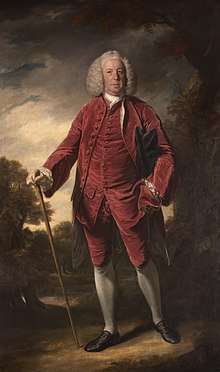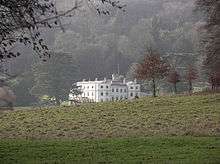Thomas Fane, 8th Earl of Westmorland
Thomas Fane, 8th Earl of Westmorland (March 1701 – 25 November 1771) was a British MP for Lyme Regis and a lord commissioner of trade. He was an ancestor of the writer George Orwell.
Thomas Fane, 8th Earl of Westmorland | |
|---|---|
 | |
| Member of the Great Britain Parliament for Lyme Regis | |
| In office 1753–1762 | |
| Preceded by |
|
| Succeeded by |
|
| Personal details | |
| Born | March 1701 |
| Died | 25 November 1771 |
| Children | |
| Father | Henry Fane of Brympton |
Biography

.jpg)
Thomas Fane was the second son of Henry Fane of Brympton d'Evercy in Somerset and Anne Scrope, sister and coheir of John Scrope. Anne and John were the grandchildren of Colonel Adrian Scrope, a regicide of Charles I. Thomas Fane inherited John Scrope's fortune and mansion in Bristol, and Colonel Adrian Scrope's property in Oxfordshire and Buckinghamshire, which included Wormsley Park.
In 1757 he succeeded his unmarried elder brother Francis to their father's Brympton estate and in 1762 inherited the title of Earl of Westmoreland from John Fane, 7th Earl of Westmorland, his father's childless second-cousin.[1] This brought him the Earls of Westmorland seat at Apethorpe Hall in Northamptonshire.
In 1727 Thomas Fane had married Elizabeth Swymmer, the daughter of a Bristol merchant and member of the slave trade, William Swymmer. The couple had two sons and two daughters, including:[2]
- John Fane, 9th Earl of Westmorland (1728–1774)
- Henry Fane (1739–1802)
- Mary, who married Charles Blair, a wealthy owner of plantations in Jamaica, at St James Westminster in 1762.[3] Charles Blair was the great-great grandfather of Eric Arthur Blair, who wrote under the pen name George Orwell.[4]
Mr Fane
In 1761 Joshua Reynolds painted his full-length portrait entitled Mr Fane. Reynolds was paid 80 guineas for the work, which depicted the powder-wigged subject walking through a wooded landscape wearing rose-coloured velvet attire. In May 1903 the portrait was sold to Martin Colnaghi for 2,100 guineas.[5]
Notes
- John Fane, 7th Earl of Westmorland, died without issue, in 1762, when the barony of Le Despencer, being a barony in fee, devolved upon his nephew Sir Francis Dashwood, bart.; but the earldom of Westmorland went to the male heir, Thomas Fane, of Bristol, merchant (and subject of this article), son of Henry Fane, (d. 1726,) attorney at law, grandson of Sir Francis Fane, K.B. and great grandson of Sir Francis Fane of Fulbeck, co. Lincoln, K.B. the third son of Francis Fane, 1st Earl of Westmorland.(Debrett 1820, 160)
- Debrett 1820, p. 161
- St James Westminster registers
- Peter Stansky, William Abrahams, William Miller Abrahams The Unknown Orwell and Orwell: The Transformation Stanford University Press, 1994 ISBN 0-8047-2342-7
- The Times Sale Of The Vaile And Other Pictures 25 May 1903
References
- Debrett, John, ed. (1820). Debrett's Correct Peerage of England, Scotland, and Ireland. 1 (13 ed.). London: Printed G. Woodall, Angel Court, Skinner Street.CS1 maint: ref=harv (link)
- Attribution

| Parliament of Great Britain | ||
|---|---|---|
| Preceded by John Scrope Robert Henley |
Member of Parliament for Lyme Regis 1753–1762 With: Robert Henley 1753–1754 Francis Fane 1754–1757 Henry Fane 1757–1762 |
Succeeded by Henry Fane Lord Burghersh |
| Peerage of England | ||
| Preceded by John Fane |
Earl of Westmorland 1762–1771 |
Succeeded by John Fane |